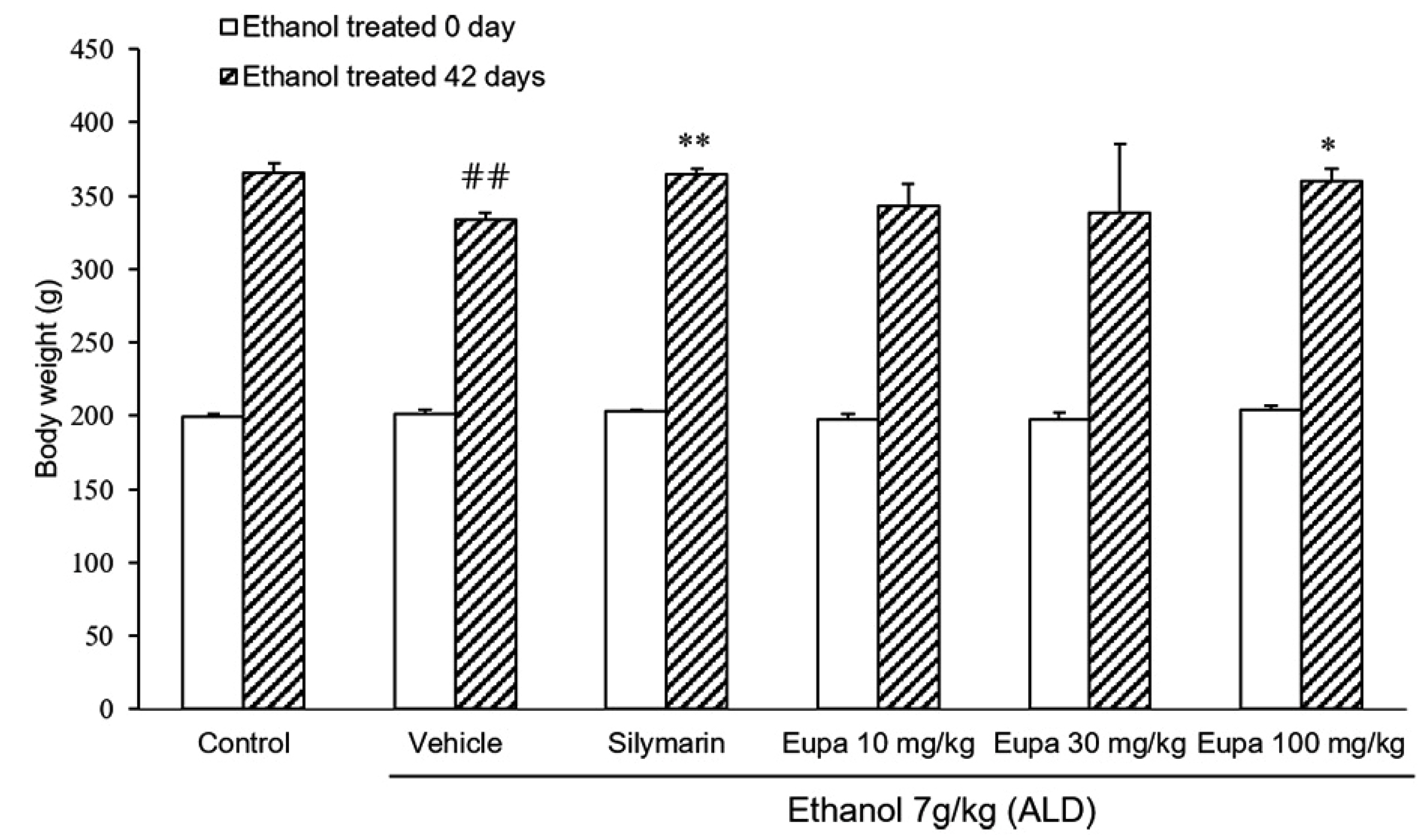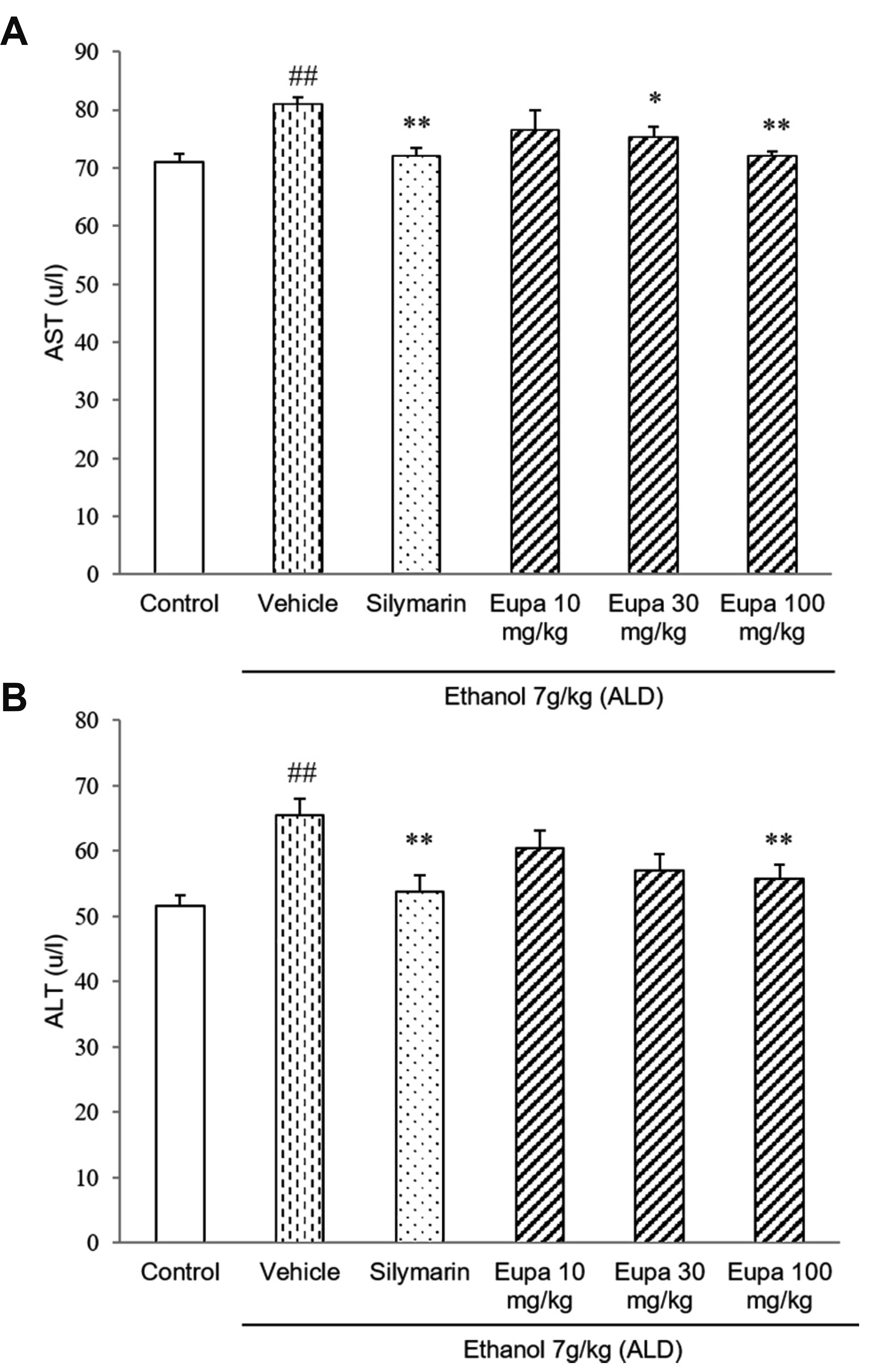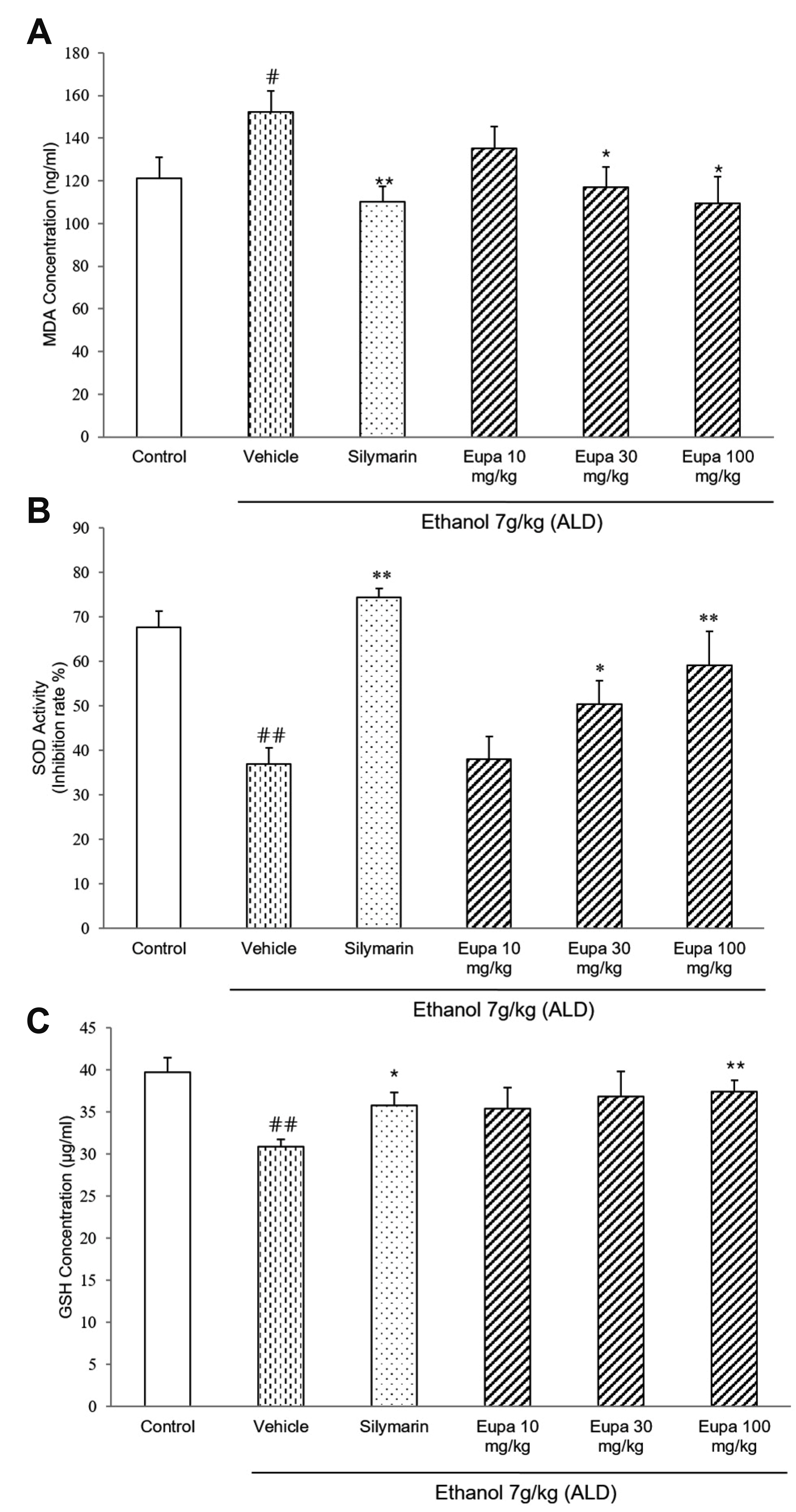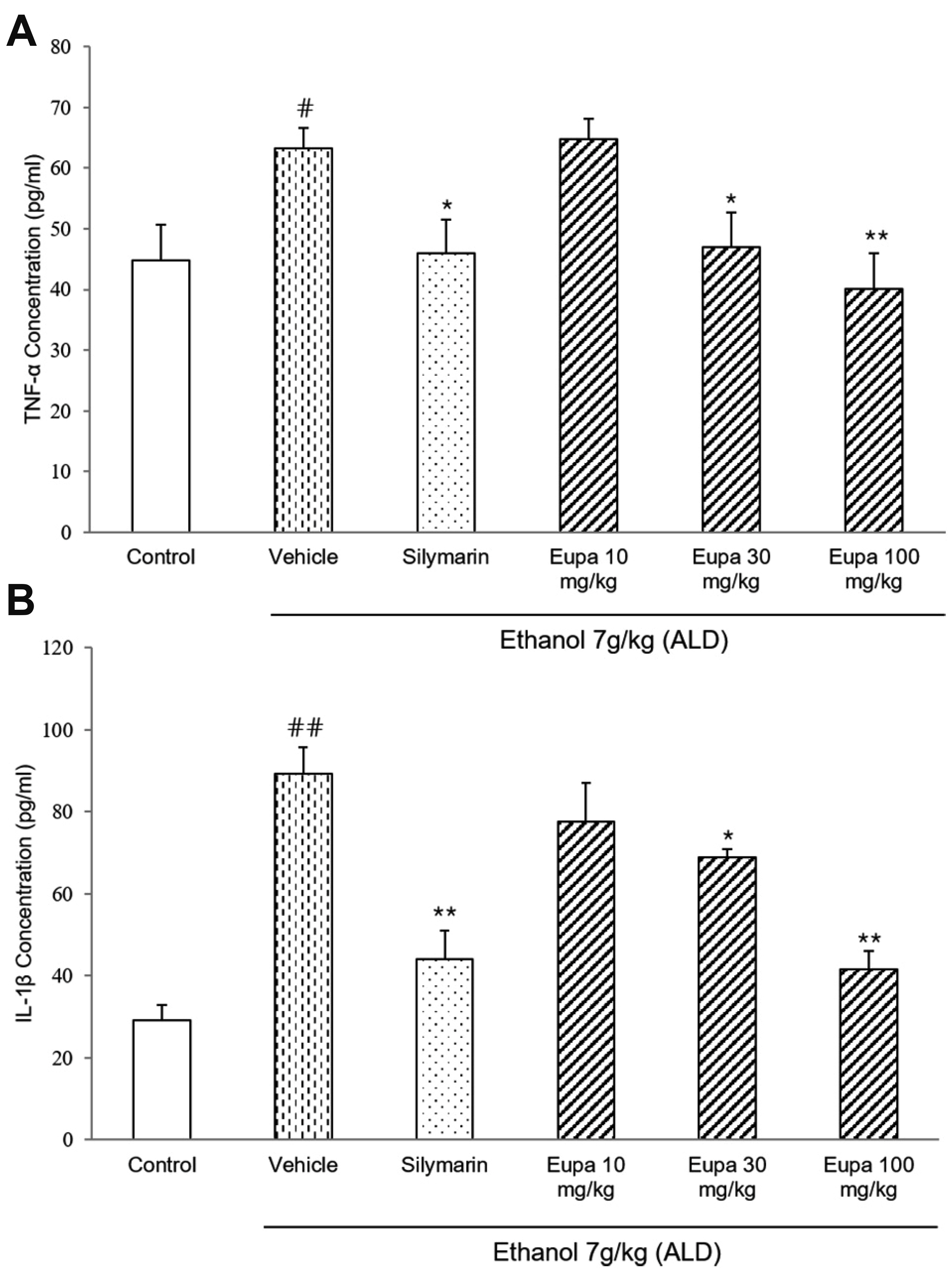Korean J Physiol Pharmacol.
2020 Sep;24(5):385-394. 10.4196/kjpp.2020.24.5.385.
The hepato-protective effect of eupatilin on an alcoholic liver disease model of rats
- Affiliations
-
- 1College of Pharmacy, Chung-Ang University, Seoul 06974, Korea
- KMID: 2505773
- DOI: http://doi.org/10.4196/kjpp.2020.24.5.385
Abstract
- Eupatilin is known to possess anti-apoptotic, anti-oxidative, and antiinflammatoryproperties. We report here that eupatilin has a protective effect onthe ethanol-induced injury in rats. Sprague–Dawley rats were divided into 6 groups:control, vehicle, silymarin, eupatilin 10 mg/kg, eupatilin 30 mg/kg, and eupatilin 100mg/kg. Plasma levels of aspartate aminotransferase (AST) and alanine aminotransferase(ALT) were analyzed to determine the extent of liver damage. Total cholesterol(TC) and triglycerides (TG) were analyzed to determine the level of liver steatosis.Malondialdehyde level, superoxide dismutase (SOD) activity, and glutathione (GSH)level were analyzed to determine the extent of oxidative stress. Tumor necrosis factor(TNF)- and interleukin (IL)-1 were quantified to verify the degree of inflammation.Based on our findings, chronic alcohol treatment significantly changed the serumindexes and liver indicators of the model rats, which were significantly improved byeupatilin treatment. Rats in the eupatilin-treatment group showed reduced levelsof AST, ALT, TG, TC, TNF-, and IL-1, increased SOD activity and GSH levels, and improvedoverall physiology compared to the alcoholic liver disease model rats. H&Estaining also verified the eupatilin-mediated improvement in liver injury. In conclusion,eupatilin inhibits alcohol-induced liver injury via its antioxidant and anti-inflammatoryeffects.
Figure
Reference
-
1. Doody EE, Groebner JL, Walker JR, Frizol BM, Tuma DJ, Fernandez DJ, Tuma PL. 2017; Ethanol metabolism by alcohol dehydrogenase or cytochrome P450 2E1 differentially impairs hepatic protein trafficking and growth hormone signaling. Am J Physiol Gastrointest Liver Physiol. 313:G558–G569. DOI: 10.1152/ajpgi.00027.2017. PMID: 28864499. PMCID: PMC5814672.2. Siegmund SV, Dooley S, Brenner DA. 2005; Molecular mechanisms of alcohol-induced hepatic fibrosis. Dig Dis. 23:264–274. DOI: 10.1159/000090174. PMID: 16508291.
Article3. Goedde HW, Agarwal DP. 1981; [Alcohol metabolizing enzymes: biochemical properties, genetic heterogeneity and their possible role in alcohol metabolism in humans (author's transl)]. J Clin Chem Clin Biochem. 19:179–189. German.4. Li CJ, Nanji AA, Siakotos AN, Lin RC. 1997; Acetaldehyde-modified and 4-hydroxynonenal-modified proteins in the livers of rats with alcoholic liver disease. Hepatology. 26:650–657. DOI: 10.1002/hep.510260317. PMID: 9303495.
Article5. Sapkota M, Hottor TK, DeVasure JM, Wyatt TA, McCaskill ML. 2014; Protective role of CYP2E1 inhibitor diallyl disulfide (DADS) on alcohol-induced malondialdehyde-deoxyguanosine (M1dG) adduct formation. Alcohol Clin Exp Res. 38:1550–1558. DOI: 10.1111/acer.12439. PMID: 24891074. PMCID: PMC4049196.
Article6. Niemelä O, Parkkila S, Ylä-Herttuala S, Halsted C, Witztum JL, Lanca A, Israel Y. 1994; Covalent protein adducts in the liver as a result of ethanol metabolism and lipid peroxidation. Lab Invest. 70:537–546.7. Kundu R, Dasgupta S, Biswas A, Bhattacharya A, Pal BC, Bandyopadhyay D, Bhattacharya S, Bhattacharya S. 2008; Cajanus cajan Linn. (Leguminosae) prevents alcohol-induced rat liver damage and augments cytoprotective function. J Ethnopharmacol. 118:440–447. DOI: 10.1016/j.jep.2008.05.010. PMID: 18584980.
Article8. Song Z, Deaciuc I, Song M, Lee DY, Liu Y, Ji X, McClain C. 2006; Silymarin protects against acute ethanol-induced hepatotoxicity in mice. Alcohol Clin Exp Res. 30:407–413. DOI: 10.1111/j.1530-0277.2006.00063.x. PMID: 16499481. PMCID: PMC4217313.
Article9. Kojima H, Sakurai S, Uemura M, Takekawa T, Morimoto H, Tamagawa Y, Fukui H. 2005; Difference and similarity between non-alcoholic steatohepatitis and alcoholic liver disease. Alcohol Clin Exp Res. 29(12 Suppl):259S–263S. DOI: 10.1097/01.alc.0000191776.37626.30. PMID: 16385233.
Article10. McCullough RL, McMullen MR, Sheehan MM, Poulsen KL, Roychowdhury S, Chiang DJ, Pritchard MT, Caballeria J, Nagy LE. 2018; Complement factor D protects mice from ethanol-induced inflammation and liver injury. Am J Physiol Gastrointest Liver Physiol. 315:G66–G79. DOI: 10.1152/ajpgi.00334.2017. PMID: 29597356. PMCID: PMC6109707.
Article11. Canbay A, Friedman S, Gores GJ. 2004; Apoptosis: the nexus of liver injury and fibrosis. Hepatology. 39:273–278. DOI: 10.1002/hep.20051. PMID: 14767974.
Article12. Han Y, Xu Q, Hu JN, Han XY, Li W, Zhao LC. 2015; Maltol, a food flavoring agent, attenuates acute alcohol-induced oxidative damage in mice. Nutrients. 7:682–696. DOI: 10.3390/nu7010682. PMID: 25608939. PMCID: PMC4303861.13. Sun X, Wang P, Yao LP, Wang W, Gao YM, Zhang J, Fu YJ. 2018; Paeonol alleviated acute alcohol-induced liver injury via SIRT1/Nrf2/NF-κB signaling pathway. Environ Toxicol Pharmacol. 60:110–117. DOI: 10.1016/j.etap.2018.04.016. PMID: 29704732.14. Jang HS, Um SI, Lee SH, Whang WK, Min YS, Park SY, Sohn UD. 2017; The protective mechanism of QGC in feline esophageal epithelial cells by interleukin-1β treatment. Arch Pharm Res. 40:204–213. DOI: 10.1007/s12272-016-0858-x. PMID: 28012047.
Article15. Nageen B, Sarfraz I, Rasul A, Hussain G, Rukhsar F, Irshad S, Riaz A, Selamoglu Z, Ali M. 2020; Eupatilin: a natural pharmacologically active flavone compound with its wide range applications. J Asian Nat Prod Res. 22:1–16. DOI: 10.1080/10286020.2018.1492565. PMID: 29973097.
Article16. Kim JS, Lee SG, Min K, Kwon TK, Kim HJ, Nam JO. 2018; Eupatilin inhibits adipogenesis through suppression of PPARγ activity in 3T3-L1 cells. Biomed Pharmacother. 103:135–139. DOI: 10.1016/j.biopha.2018.03.073. PMID: 29649628.
Article17. Kim M, Min YS, Sohn UD. 2018; Cytoprotective effect of eupatilin against indomethacin-induced damage in feline esophageal epithelial cells: relevance of HSP27 and HSP70. Arch Pharm Res. 41:1019–1031. DOI: 10.1007/s12272-018-1066-7. PMID: 30109575.
Article18. Ryoo SB, Oh HK, Yu SA, Moon SH, Choe EK, Oh TY, Park KJ. 2014; The effects of eupatilin (stillen®) on motility of human lower gastrointestinal tracts. Korean J Physiol Pharmacol. 18:383–390. DOI: 10.4196/kjpp.2014.18.5.383. PMID: 25352757. PMCID: PMC4211121.
Article19. Choi EJ, Oh HM, Na BR, Ramesh TP, Lee HJ, Choi CS, Choi SC, Oh TY, Choi SJ, Chae JR, Kim SW, Jun CD. 2008; Eupatilin protects gastric epithelial cells from oxidative damage and down-regulates genes responsible for the cellular oxidative stress. Pharm Res. 25:1355–1364. DOI: 10.1007/s11095-008-9531-5. PMID: 18299966.
Article20. Yoo BM, Oh TY, Kim YB, Yeo M, Lee JS, Surh YJ, Ahn BO, Kim WH, Sohn S, Kim JH, Hahm KB. 2005; Novel antioxidant ameliorates the fibrosis and inflammation of cerulein-induced chronic pancreatitis in a mouse model. Pancreatology. 5:165–176. DOI: 10.1159/000085268. PMID: 15849487.
Article21. Zhou K, Cheng R, Liu B, Wang L, Xie H, Zhang C. 2018; Eupatilin ameliorates dextran sulphate sodium-induced colitis in mice partly through promoting AMPK activation. Phytomedicine. 46:46–56. DOI: 10.1016/j.phymed.2018.04.033. PMID: 30097122.
Article22. Oh TY, Lee JS, Ahn BO, Cho H, Kim WB, Kim YB, Surh YJ, Cho SW, Hahm KB. 2001; Oxidative damages are critical in pathogenesis of reflux esophagitis: implication of antioxidants in its treatment. Free Radic Biol Med. 30:905–915. DOI: 10.1016/S0891-5849(01)00472-5. PMID: 11295533.
Article23. Ryu BK, Ahn BO, Oh TY, Kim SH, Kim WB, Lee EB. 1998; Studies on protective effect of DA-9601, Artemisia asiatica extract, on acetaminophen- and CCl4-induced liver damage in rats. Arch Pharm Res. 21:508–513. DOI: 10.1007/BF02975366. PMID: 9875486.24. Park SC, Yoon JH, Kim W, Gwak GY, Kim KM, Lee SH, Lee SM, Lee HS. 2006; Eupatilin attenuates bile acid-induced hepatocyte apoptosis. J Gastroenterol. 41:772–778. DOI: 10.1007/s00535-006-1854-6. PMID: 16988766.
Article25. Parvez MK, Arbab AH, Al-Dosari MS, Al-Rehaily AJ, Alam P, Ibrahim KE, Alsaid MS, Rafatullah S. 2018; Protective effect of Atriplex suberecta extract against oxidative and apoptotic hepatotoxicity. Exp Ther Med. 15:3883–3891. DOI: 10.3892/etm.2018.5919. PMID: 29581744. PMCID: PMC5863606.26. Kim D, Kim GW, Lee SH, Han GD. 2016; Ligularia fischeri extract attenuates liver damage induced by chronic alcohol intake. Pharm Biol. 54:1465–1473. DOI: 10.3109/13880209.2015.1104701. PMID: 26799831.27. Yu K, Li XM, Xu XL, Zhang RY, Cong HL. 2015; Eupatilin protects against tumor necrosis factor-α-mediated inflammation inhuman umbilical vein endothelial cells. Int J Clin Exp Med. 8:22191–22197.28. Qiao Z, Xu YW, Yang J. 2016; Eupatilin inhibits the apoptosis in H9c2 cardiomyocytes via the Akt/GSK-3β pathway following hypoxia/reoxygenation injury. Biomed Pharmacother. 82:373–378. DOI: 10.1016/j.biopha.2016.05.026. PMID: 27470375.
Article29. Wang X, Ren J, Zhu S, Ren G, Wang L, Chen X, Qiu Z, Zhang C. 2018; Pharmacokinetics and tissue distribution of eupatilin and its metabolite in rats by an HPLC-MS/MS method. J Pharm Biomed Anal. 159:113–118. DOI: 10.1016/j.jpba.2018.06.037. PMID: 29980012.
Article30. Adaramoye OA, Aluko A, Oyagbemi AA. 2011; Cnidoscolus aconitifolius leaf extract protects against hepatic damage induced by chronic ethanol administration in Wistar rats. Alcohol Alcohol. 46:451–458. DOI: 10.1093/alcalc/agr060. PMID: 21616948.
Article31. Araújo Júnior RF, Garcia VB, Leitão RF, Brito GA, Miguel Ede C, Guedes PM, de Araújo AA. 2016; Carvedilol improves inflammatory response, oxidative stress and fibrosis in the alcohol-induced liver injury in rats by regulating Kuppfer cells and hepatic stellate cells. PLoS One. 11:e0148868. DOI: 10.1371/journal.pone.0148868. PMID: 26891124. PMCID: PMC4758650.
Article32. Liu R, Chen QH, Ren JW, Sun B, Cai XX, Li D, Mao RX, Wu X, Li Y. 2018; Ginseng (Panax ginseng Meyer) oligopeptides protect against binge drinking-induced liver damage through inhibiting oxidative stress and inflammation in rats. Nutrients. 10:1665. DOI: 10.3390/nu10111665. PMID: 30400371. PMCID: PMC6266439.
Article33. Ilaiyaraja N, Khanum F. 2011; Amelioration of alcohol-induced hepatotoxicity and oxidative stress in rats by Acorus calamus. J Diet Suppl. 8:331–345. DOI: 10.3109/19390211.2011.615805. PMID: 22432772.34. Liangpunsakul S, Crabb DW, Qi R. 2010; Relationship among alcohol intake, body fat, and physical activity: a population-based study. Ann Epidemiol. 20:670–675. DOI: 10.1016/j.annepidem.2010.05.014. PMID: 20696406. PMCID: PMC2921229.
Article35. Rejitha S, Prathibha P, Indira M. 2012; Amelioration of alcohol-induced hepatotoxicity by the administration of ethanolic extract of Sida cordifolia Linn. Br J Nutr. 108:1256–1263. DOI: 10.1017/S0007114511006568. PMID: 22289614.36. Hsieh YL, Yeh YH, Lee YT, Huang CY. 2015; Protective effects of Cholestin on ethanol induced oxidative stress in rats. J Sci Food Agric. 95:799–808. DOI: 10.1002/jsfa.6904. PMID: 25200286.
Article37. Huang H, Lin Z, Zeng Y, Lin X, Zhang Y. 2019; Probiotic and glutamine treatments attenuate alcoholic liver disease in a rat model. Exp Ther Med. 18:4733–4739. DOI: 10.3892/etm.2019.8123.
Article38. Zhou J, Zhang J, Wang C, Qu S, Zhu Y, Yang Z, Wang L. 2018; Açaí (Euterpe oleracea Mart.) attenuates alcohol-induced liver injury in rats by alleviating oxidative stress and inflammatory response. Exp Ther Med. 15:166–172. DOI: 10.3892/etm.2017.5427.
Article39. Lee IS, Park S, Park K, Choue R. 2011; Hepatoprotective activity of scutellariae radix extract in mice fed a high fat diet with chronic alcohol exposure. Phytother Res. 25:1348–1353. DOI: 10.1002/ptr.3370. PMID: 21341335.
Article40. Radosavljević T, Mladenović D, Vucević D. 2009; [The role of oxidative stress in alcoholic liver injury]. Med Pregl. 62:547–553. Serbian. DOI: 10.2298/MPNS0912547R. PMID: 20491381.
Article41. Cai Z, Shi T, Zhuang R, Fang H, Jiang X, Shao Y, Zhou H. 2018; Protective effect of N-acetylcysteine activated carbon release microcapsule on myocardial ischemia-reperfusion injury in rats. Exp Ther Med. 15:1809–1818. DOI: 10.3892/etm.2017.5653. PMID: 29434769. PMCID: PMC5776512.
Article42. Zhang C, Shi S. 2018; Physiological and proteomic responses of contrasting alfalfa (Medicago sativa L.) varieties to PEG-induced osmotic stress. Front Plant Sci. 9:242. DOI: 10.3389/fpls.2018.00242. PMID: 29541085. PMCID: PMC5835757.
Article43. Turan A, Celik I. 2016; Antioxidant and hepatoprotective properties of dried fig against oxidative stress and hepatotoxicity in rats. Int J Biol Macromol. 91:554–559. DOI: 10.1016/j.ijbiomac.2016.06.009. PMID: 27268385.
Article44. Ma J, Li M, Kalavagunta PK, Li J, He Q, Zhang Y, Ahmad O, Yin H, Wang T, Shang J. 2018; Protective effects of cichoric acid on H2O2-induced oxidative injury in hepatocytes and larval zebrafish models. Biomed Pharmacother. 104:679–685. DOI: 10.1016/j.biopha.2018.05.081. PMID: 29803928.45. Muller FL, Song W, Liu Y, Chaudhuri A, Pieke-Dahl S, Strong R, Huang TT, Epstein CJ, Roberts LJ 2nd, Csete M, Faulkner JA, Van Remmen H. 2006; Absence of CuZn superoxide dismutase leads to elevated oxidative stress and acceleration of age-dependent skeletal muscle atrophy. Free Radic Biol Med. 40:1993–2004. DOI: 10.1016/j.freeradbiomed.2006.01.036. PMID: 16716900.
Article46. García-Niño WR, Zatarain-Barrón ZL, Hernández-Pando R, Vega-García CC, Tapia E, Pedraza-Chaverri J. 2015; Oxidative stress markers and histological analysis in diverse organs from rats treated with a hepatotoxic dose of Cr(VI): effect of curcumin. Biol Trace Elem Res. 167:130–145. DOI: 10.1007/s12011-015-0283-x. PMID: 25774041.
Article47. Deng Y, Xu Z, Xu B, Liu W, Feng S, Yang T. 2014; Antioxidative effects of schidandrin B and green tea polyphenols against mercuric chloride-induced hepatotoxicity in rats. J Environ Pathol Toxicol Oncol. 33:349–361. DOI: 10.1615/JEnvironPatholToxicolOncol.2014011859. PMID: 25404381.
Article48. Perdices L, Fuentes-Broto L, Segura F, Ben Gdara N, Sánchez-Cano AI, Insa G, Orduna E, Pinilla I. 2018; Hepatic oxidative stress in pigmented P23H rhodopsin transgenic rats with progressive retinal degeneration. Free Radic Biol Med. 124:550–557. DOI: 10.1016/j.freeradbiomed.2018.07.005. PMID: 30006118.
Article49. Li YG, Ji DF, Chen S, Hu GY. 2008; Protective effects of sericin protein on alcohol-mediated liver damage in mice. Alcohol Alcohol. 43:246–253. DOI: 10.1093/alcalc/agm164. PMID: 18263900.
Article50. Mallikarjuna K, Shanmugam KR, Nishanth K, Wu MC, Hou CW, Kuo CH, Reddy KS. 2010; Alcohol-induced deterioration in primary antioxidant and glutathione family enzymes reversed by exercise training in the liver of old rats. Alcohol. 44:523–529. DOI: 10.1016/j.alcohol.2010.07.004. PMID: 20705416.
Article51. Park SW, Oh TY, Kim YS, Sim H, Park SJ, Jang EJ, Park JS, Baik HW, Hahm KB. 2008; Artemisia asiatica extracts protect against ethanol-induced injury in gastric mucosa of rats. J Gastroenterol Hepatol. 23:976–984. DOI: 10.1111/j.1440-1746.2008.05333.x. PMID: 18444990.
Article52. Joo M, Kim HS, Kwon TH, Palikhe A, Zaw TS, Jeong JH, Sohn UD. 2015; Anti-inflammatory effects of flavonoids on TNBS-induced colitis of rats. Korean J Physiol Pharmacol. 19:43–50. DOI: 10.4196/kjpp.2015.19.1.43. PMID: 25605996. PMCID: PMC4297761.
Article53. Palenski TL, Sorenson CM, Sheibani N. 2013; Inflammatory cytokine-specific alterations in retinal endothelial cell function. Microvasc Res. 89:57–69. DOI: 10.1016/j.mvr.2013.06.007. PMID: 23806781. PMCID: PMC3764503.
Article54. Lin HZ, Yang SQ, Zeldin G, Diehl AM. 1998; Chronic ethanol consumption induces the production of tumor necrosis factor-alpha and related cytokines in liver and adipose tissue. Alcohol Clin Exp Res. 22(5 Suppl):231S–237S. DOI: 10.1111/j.1530-0277.1998.tb04008.x.
Article55. Kim YD, Lee KM, Hwang SL, Chang HW, Kim KJ, Harris RA, Choi HS, Choi WS, Lee SE, Park CS. 2015; Inhibition of cereblon by fenofibrate ameliorates alcoholic liver disease by enhancing AMPK. Biochim Biophys Acta. 1852:2662–2670. DOI: 10.1016/j.bbadis.2015.09.014. PMID: 26410577.
Article56. Zhang Y, Wang C, Yu B, Jiang JD, Kong WJ. 2018; Gastrodin protects against ethanol-induced liver injury and apoptosis in HepG2 cells and animal models of alcoholic liver disease. Biol Pharm Bull. 41:670–679. DOI: 10.1248/bpb.b17-00825. PMID: 29709905.
Article
- Full Text Links
- Actions
-
Cited
- CITED
-
- Close
- Share
- Similar articles
-
- Should you advocate for hepatocellular carcinomasurveillance in patients with alcohol-related liverdisease or non-alcoholic fatty liver disease?
- An Activation of Peroxisome Proliferator-Activated Receptor delta Attenuate Alcoholic Liver Disease and Nonalcoholic Fatty Liver Disease in Rats
- Silymarin's Protective Effects and Possible Mechanisms on Alcoholic Fatty Liver for Rats
- KASL Clinical Practice Guidelines: Management of Alcoholic Liver Disease
- Current Status of Deceased Donor Liver Transplantation for Alcoholic Liver Disease in Korea in MELD Era







